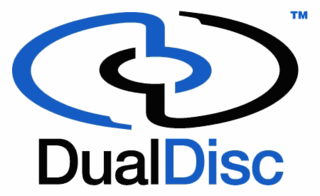
The compact disc (CD) is a digital optical disc data storage format that was co-developed by Philips and Sony to store and play digital audio recordings. In August 1982, the first compact disc was manufactured. It was then released in October 1982 in Japan and branded as Digital Audio Compact Disc. In terms of both audio formatting and the music industry, CDs reached their peak popularity in the 1990s, and has steadily declined since due to the rise of downloadable MP3 formats and streaming.

CD-R is a digital optical disc storage format. A CD-R disc is a compact disc that can be written once and read arbitrarily many times.

An optical disc is a flat, usually disc-shaped object that stores information in the form of physical variations on its surface that can be read with the aid of a beam of light. Optical discs can be reflective, where the light source and detector are on the same side of the disc, or transmissive, where light shines through the disc to be detected on the other side.

Video CD is a home video format and the first format for distributing films on standard 120 mm (4.7 in) optical discs. The format was widely adopted in Southeast Asia, South Asia, East Asia, Central Asia and West Asia, superseding the VHS and Betamax systems in the regions until DVD-Video finally became affordable in the first decade of the 21st century.

Super Audio CD (SACD) is an optical disc format for audio storage introduced in 1999. It was developed jointly by Sony and Philips Electronics and intended to be the successor to the compact disc (CD) format.

The LaserDisc (LD) is a home video format and the first commercial optical disc storage medium, initially licensed, sold and marketed as MCA DiscoVision in the United States in 1978. Its diameter typically spans 30 cm (12 in). Unlike most optical-disc standards, LaserDisc is not fully digital, and instead requires the use of analog video signals.

In computing, an optical disc drive is a disc drive that uses laser light or electromagnetic waves within or near the visible light spectrum as part of the process of reading or writing data to or from optical discs. Some drives can only read from certain discs, but recent drives can both read and record, also called burners or writers. Compact discs, DVDs, and Blu-ray discs are common types of optical media which can be read and recorded by such drives.

The DualDisc is a type of double-sided optical disc product developed by a group of record companies including MJJ Productions Inc., EMI Music, Universal Music Group, Sony BMG Music Entertainment, Warner Music Group, and 5.1 Entertainment Group and later under the aegis of the Recording Industry Association of America (RIAA). It featured an audio layer intended to be compatible with CD players on one side and a standard DVD layer on the other. In this respect it was similar to, but distinct from, the DVDplus developed in Europe by Dieter Dierks and covered by European patents.

DTS, Inc. is an American company, DTS company makes multichannel audio technologies for film and video. Based in Calabasas, California, the company introduced its DTS technology in 1993 as a competitor to Dolby Laboratories, incorporating DTS in the film Jurassic Park (1993). The DTS product is used in surround sound formats for both commercial/theatrical and consumer-grade applications. It was known as The Digital Experience until 1995. DTS licenses its technologies to consumer electronics manufacturers.
DVD formats describe the physical properties of the optical disc and how data is stored and manipulated on the disc. The formats are varied according to use, with the largest differences being whether or not the disc is written to. Within each use category, there are often competing formats or implementations.

Optical storage refers to a class of data storage systems that use light to read or write data to an underlying optical media. Although a number of optical formats have been used over time, the most common examples are optical disks like the compact disc (CD) and DVD. Reading and writing methods have also varied over time, but most modern systems as of 2023 use lasers as the light source and use it both for reading and writing to the discs. Britannica notes that it "uses low-power laser beams to record and retrieve digital (binary) data."

DVD recordable and DVD rewritable are optical disc recording technologies. Both terms describe DVD optical discs that can be written to by a DVD recorder, whereas only 'rewritable' discs are able to erase and rewrite data. Data is written ('burned') to the disc by a laser, rather than the data being 'pressed' onto the disc during manufacture, like a DVD-ROM. Pressing is used in mass production, primarily for the distribution of home video.

CD-RW is a digital optical disc storage format introduced in 1997. A CD-RW compact disc (CD-RWs) can be written, read, erased, and re-written.

This article compares the technical specifications of multiple high-definition formats, including HD DVD and Blu-ray Disc; two mutually incompatible, high-definition optical disc formats that, beginning in 2006, attempted to improve upon and eventually replace the DVD standard. The two formats remained in a format war until February 19, 2008, when Toshiba, HD DVD's creator, announced plans to cease development, manufacturing and marketing of HD DVD players and recorders.

The DVD is a digital optical disc data storage format. It was invented and developed in 1995 and first released on November 1, 1996, in Japan. The medium can store any kind of digital data and has been widely used for video programs or formerly for storing software and other computer files as well. DVDs offer significantly higher storage capacity than compact discs (CD) while having the same dimensions. A standard single-layer DVD can store up to 4.7 GB of data, a dual-layer DVD up to 8.5 GB. Variants can store up to a maximum of 17.08 GB.

Blu-ray is a digital optical disc data storage format designed to supersede the DVD format. It was invented and developed in 2005 and released worldwide on June 20, 2006, capable of storing several hours of high-definition video. The main application of Blu-ray is as a medium for video material such as feature films and for the physical distribution of video games for the PlayStation 3, PlayStation 4, PlayStation 5, Xbox One, and Xbox Series X. The name refers to the blue laser used to read the disc, which allows information to be stored at a greater density than is possible with the longer-wavelength red laser used for DVDs.

HD DVD is an obsolete high-density optical disc format for storing data and playback of high-definition video. Supported principally by Toshiba, HD DVD was envisioned to be the successor to the standard DVD format, but lost to Blu-ray, supported by Sony and others.

A CD-ROM is a type of read-only memory consisting of a pre-pressed optical compact disc that contains data. Computers can read—but not write or erase—CD-ROMs. Some CDs, called enhanced CDs, hold both computer data and audio with the latter capable of being played on a CD player, while data is only usable on a computer.

In computer science, a double-sided disk is a disk of which both sides are used to store data.

Super Video CD is a digital format for storing video on standard compact discs. SVCD was intended as a successor to Video CD and an alternative to DVD-Video, and falls somewhere between both in terms of technical capability and picture quality.

















